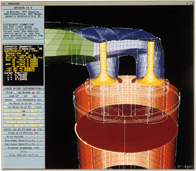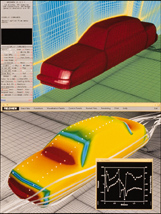Grid Work
An interactive, graphically-oriented software system that generates three-dimensional, multiple block, structured grids has gained wide popularity with scientists and engineers.
Originally developed for the U.S. Air Force by a major aerospace firm, the software produces computational grids for engineering analysis, primarily computational fluid dynamics (CFD). Both Langley Research Center and Ames Research Center played important roles in expanding its use throughout NASA, to solve more complex CFD problems with greater efficiency.
NASA delivered the software in 1994 to the Computer Software Management and Information Center (COSMIC). Government-developed computer programs adaptable to secondary use are maintained at COSMIC. That same year, the software's source code was made available for enhancement and commercialization. Today, Pointwise, Inc. of Fort Worth, Texas is offering for commercial purchase the augmented grid software.
"NASA's willingness to distribute this technology allowed more than 300 individuals at various governmental and industrial agencies to gain quick access to the software," says John Steinbrenner, Pointwise Vice President, Research & Development.
Pointwise is a supplier to the engineering analysis community of the grid generation software known as Gridgen. A complete line of services is centered around the software. Scientists and engineers prepare geometry data for computer simulations of fluid flow by tapping the strengths of the software system. The enabling software bridges computer-aided design (CAD) software and analysis software such as CFD and finite element analysis (FEA). A favored tool in the demanding aerospace industry, the high quality grids are in use in fields ranging from automotive to turbomachinery.
A unique aspect of Pointwise's grid software is that it decomposes an experimental shape's three-dimensional domain into contiguous sub-domains called blocks. Grids on the surface of each block are generated, followed by the volume grids within.
"It's like a computer-aided design system," says Pointwise's president, John Chawner, "where instead of drawing the experimental shape, we're creating the grid around it. Our approach to making complex problems as simple as possible is to make the code graphical and handle the bookkeeping automatically."
Challenging shapes? No problem, as multiple block, structured grids, and three-dimensional space can break into any number of contiguous blocks, each in its own computational space. Furthermore, the system defies memory limitations. A flowfield, for example, that demands millions of grid points may exceed available memory. But, by apportioning grid points among several blocks and doing the calculations on them one at a time, the flowfield can be resolved.
Speed...space...and time. The software can render the flowfields slipping over the supersonic skin of a high-performance jet aircraft. This can be done as efficiently as laying out the surface grids for the bifurcation region of the carotid artery.
Pointwise's flagship software has been distributed to over 300 sites and has been used to create grids for spacecraft, fighter aircraft, internal and external flowfields, missiles, submarines, surface vessels, sailboats, and turbomachinery. A wide divergent group of users now depends on the powerful software system, be they in industry, government laboratories, or academia. The company has formed alliances with two other firms, further expanding the development and sale of the software to aerospace, automotive, and mechanical engineering markets.
Since it began selling the software in 1995, Pointwise has released refined versions of the product. In July 1997, the company announced the availability of version 12 of the numerical grid generation software. In 1998, they will introduce an even more powerful version that includes the ability to create unstructured grids for handling even more complex shapes.

Computer-generated grids for engineering analysis have become a boon for manufacturers. Software has been made available from NASA's COSMIC system for secondary use of government-developed computer programs.

Pointwise, Inc. has updated and modified government-produced software for commercial sale. Computational grids produced by the software are of great help in automotive design work.













